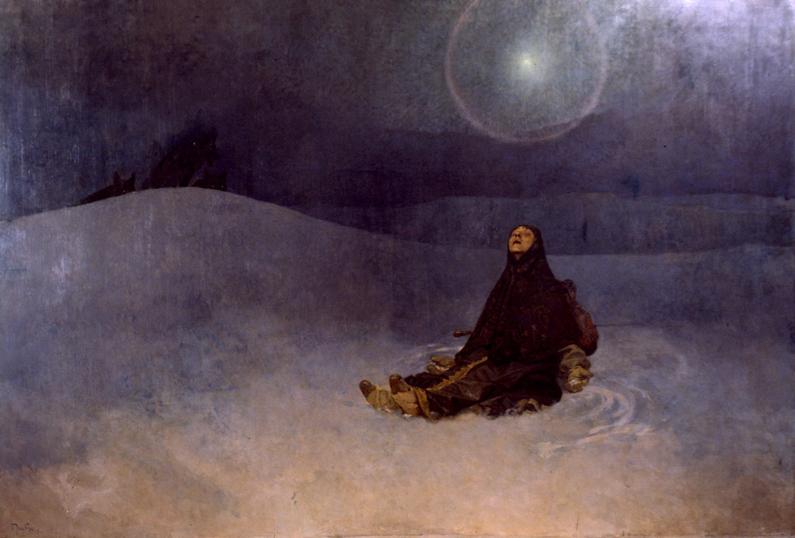
Alphonse Mucha was a Czech painter and illustrator who lived from July 24, 1860, to July 14, 1939. He is famously known for his Art Nouveau posters for plays performed in Paris that starred one of the most known actors of all time, Sarah Bernhardt. In addition, he produced the 20 colossal paintings known as the “Slav Epic” toward the end of his career, depicting the Slavic people’s history.
Alphonse Mucha was born into a working-class family in southern Moravia, formerly in the Austro-Hungarian Empire and now in the Czech Republic. As a young child, Mucha showed a talent for drawing. Paper was a luxury then, but a local shop owner moved by Mucha’s talent gifted it.
Alphonse Mucha attempted to enroll in the Prague Academy of Fine Arts in 1878 but was rejected. He moved to Vienna in 1880 at 19, where he worked as an apprentice scenery painter in neighborhood theaters.
Unfortunately, the Ringtheater, a crucial client of Mucha’s business, burned down in 1881, leaving Mucha jobless. He returned to Moravia, where he met the young artist’s patron, Count Khuen Belasi. Alphonse Mucha enrolled in the Munich Academy of Fine Arts using funding provided by Count Khuen.
Parisian success and an art student
Much is known about Alphonse Mucha’s relocation to Paris in 1888. The famous artist first joined the Academie Julian and later enrolled at the Academie Colarossi. After becoming acquainted with numerous other struggling artists, such as the Czech illustrator Ludek Marold, Alphonse Mucha began his income-generating career as a magazine illustrator.
After becoming close friends, Mucha and Paul Gauguin decided to share a studio for some time. His friendship with Swedish playwright August Strindberg also deepened.
Working with Sarah Bernhardt
Mucha was in the perfect situation at the ideal time in late 1894. One of the most well-known actors in the world, Sarah Bernhardt, contacted the publishing house Lemercier to have a poster created for the latest play, Gismonda. Manager Maurice de Brunhoff was with artist Mucha at the publishing house when the call came in.
Brunhoff asked Mucha to make a new poster because he was willing and could finish the task in a couple of weeks. The end masterpiece was a larger-than-life-size representation of Sarah Bernhardt playing the play’s main character.
Mucha gained overnight fame after having his artwork displayed all over Paris. He was hired to create the official posters for each play by Sarah Bernhardt.
Nouveau Art
Painter Alphonse Mucha is an important figure in the developing Art Nouveau movement. He received numerous other illustration commissions due to his success in creating the posters for Sarah Bernhardt. In addition, he produced various advertisements for goods ranging from bicycles to baby food.
He also created the magazine La Plume’s famous artistic and literary review cover illustrations. His art often depicted women in opulent natural settings covered in flowers and other organic elements.
The 20th Century Paris Universal Exposition showcased a sizable menu of Art Nouveau. The exposition showcased the handiwork of multiple French designers. Most premises to host the event featured architectural masterpieces of Art Nouveau. The Austro-Hungarian government even received an application from Alphonse Mucha to paint murals for the Bosnia and Herzegovina pavilion.
The gifted artist first planned to depict various scenes of suffering inflicted by foreign marauders on Slavic locals. Unfortunately, the authorities turned down the suggestion. Mucha eventually created a more positive production, featuring the legendary Bosnia and Herzegovinian customary traditions.
In recognition of these achievements, Austria-Hungary’s ruler, Franz Joseph I, famously honored Mucha with a knighthood. In addition, the French rulers in Paris later honored Mucha with the coveted Legion of Honor accolade.
After the Paris event, Georges Fouquet, a renowned merchant, later commissioned Mucha to devise an artistic architectural plan for his new shop in Paris. This was inaugurated in 1901; it had an Art Nouveau-inspired décor.
Slav Epic

The Slav Epic – Alphonse Maria Mucha
Alphonse Mucha continued to produce illustrations throughout the first decade of the 20th century, but he persisted in painting murals that showed the suffering of the Slavic people. In 1904, he visited America to secure funding for his project. Two months later, he returned to Paris, but in 1906, he returned to the United States and stayed there for three years.
The celebrated artist made a quick fortune in his years of vacation in the US, where he worked as a teacher. At this time, Mucha also had a memorable stint at Chicago’s Art Institute, working as a visiting professor. Nevertheless, the disenchanted Mucha felt the US academic atmosphere could not afford him the backing he needed to thrive as an art scholar. So the scholarly painter unceremoniously decided to troop back to the European continent around 1909.
In retrospect, Mucha was more fortunate in February 2010. He met Charles Richard Crane in Chicago; his father had made a fortune selling plumbing parts, and he was the heir.
Crane finally consented to provide funding for the creation of what became known as the “Slav Epic” nearly a year after Mucha returned to Europe. He also consented to present the Prague government with the finished pieces once they were complete.
The twenty masterpieces that make up the “Slav Epic” were created throughout Mucha’s 18-year career, from 1910 to 1928. He continued to work during the declaration of the new Republic of Czechoslovakia and World War I. One exhibition of the finished paintings took place in 1928, during Mucha’s lifetime. They were later rolled up and stored.
Conclusion
Alphonse Mucha resisted attempts to link him to Art Nouveau during his lifetime, but his works are essential to understanding the movement. He took the utmost pride in his historical paintings by the time of his passing. When Mucha passed away, his art was outdated, but it is now very well-known and appreciated.




